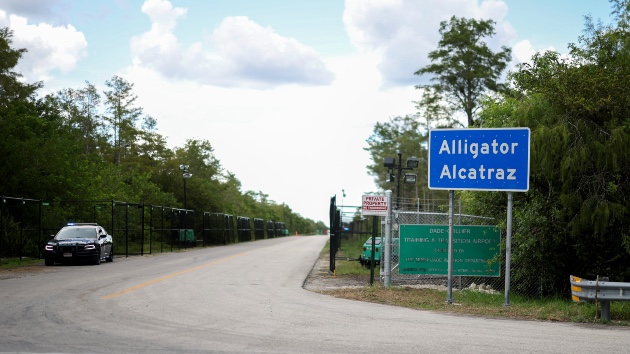
(NEW YORK) — Known for the eponymous reptiles that inhabit the nearby swamps, the migrant detention center dubbed “Alligator Alcatraz” faces the possibility of being shut down over concerns about some of the area’s lesser-known inhabitants — the Everglades’ bats, panthers, and storks.
At a hearing in federal court Wednesday, environmental groups have so far called two witnesses as part of their effort to prove that facility was built without the federally required impact studies.
Attorneys representing Florida officials have argued that the facility was initially funded by, constructed, and managed by the state and is therefore exempt from the National Environmental Policy Act – the main law being used to challenge the facility.
To counter that, the environmental groups called Florida state Rep. Anna Eskamani, who testified that she understood that the Department of Homeland Security was the driving force behind the facility.
During a guided tour she took of the facility last month, Florida Division of Emergency Management Executive Kevin Guthrie allegedly told Eskamani and other lawmakers that Alligator Alcatraz was built at the direct request of the Department of Homeland Security and in compliance with Immigration and Customs Enforcement.
“DHS made the request for a facility to be established, and this was the product of that facility,” she testified. “They kept asserting to us that they were following all federal and state guidelines, and ICE inspects our facility.”
Alligator Alcatraz has so far operated in what immigration advocates have described as a jurisdictional gray zone — with the facility funded by the federal government but run by the state of Florida — that they allege allows officials to skirt some legal requirements.
Florida Gov. Ron DeSantis has previously argued that the state of Florida is “implementing” the federal government’s immigration policy with the expectation that the state would be fully reimbursed for the costs of Alligator Alcatraz, but local and federal officials have so far been unable to tell the federal courts who is actually in charge of the facility.
The hearing — at which federal, state, and tribal officials are testifying — comes amid heightened scrutiny of the facility, which was once touted as a “one-stop shop to carry out President Trump’s mass deportation agenda.”
Located 50 miles west of Miami in the heart of the Florida Everglades, “Alligator Alcatraz” was quickly constructed over a matter of weeks, utilizing hundreds of tents, trailers, and other temporary facilities to potentially house more than 3,000 detainees.
The facility was built on the grounds of the Dade-Collier Training and Transition Airport, a sparsely used piece of tarmac owned by Miami-Dade County.
Alligator Alcatraz also neighbors land leased to the Miccosukee Indian Tribe, including villages, a school, traditional hunting areas, and sacred sites. The Miccosukee Tribe joined the lawsuit last month, arguing that the facility threatens to damage nearby tribal villages.
The environmental groups and the tribe that brought the case allege that the sprawling facility was built without the federal or state government conducting an environmental impact statement, which is required under the National Environmental Policy Act (NEPA), so the public and lawmakers can understand the impact of a project. They also argue that the government failed to get public input on the project.
The Department of Justice has also argued that the environmental groups cannot prove irreparable harm and that NEPA does not give a court the power to block the use of the facility.
Attorneys representing the Florida officials tried to cast doubt on Eskamani’s testimony by arguing she has publicly opposed the policy, including saying at one point that the facility was a “half-billion-dollar anti-immigrant grift.”
“I can definitely see myself saying that on social media,” she told the court about the comments.
Eskamani also testified about the environmental impacts of the facility, which she said was described to her by state officials as an “active construction site.” Miles of barbed wire, tons of freshly laid asphalt, and hundreds of high-power lights peppered the facility.
Eve Samples, the executive director of the nonprofit Friends of the Everglades, which brought the lawsuit, testified before Eskamani on Wednesday and argued that the environmental impact has already been felt at the site. The construction of the facility brought increased traffic to the sensitive area, and high-power lights have made the facility visible at night from miles away.
The facility sits next to the Big Cypress National Preserve and the Big Cypress Area, ecologically sensitive and protected areas that house threatened species, including the Everglade snail kite, Florida panther, wood stork, and Florida bonneted bat.
Jesse Michael Panuccio, a lawyer representing Florida, tried to blunt her testimony by highlighting that the facility was built on a preexisting airport, where hundreds of planes take off and land daily.
While Wednesday’s hearing is limited to environmental issues — including impacts on the nearby Big Cypress National Preserve — the testimony is expected to shine a light on the operations of the facility and could result in a federal judge ordering the facility to be shut down until the required environmental impact studies are conducted.
Immigrant advocates have alleged that detainees have endured inhumane conditions, including flooded facilities, spoiled food, and sweltering heat — and that they have limited access to their attorneys and are effectively housed in a jurisdictional “black hole.”
Copyright © 2025, ABC Audio. All rights reserved.



